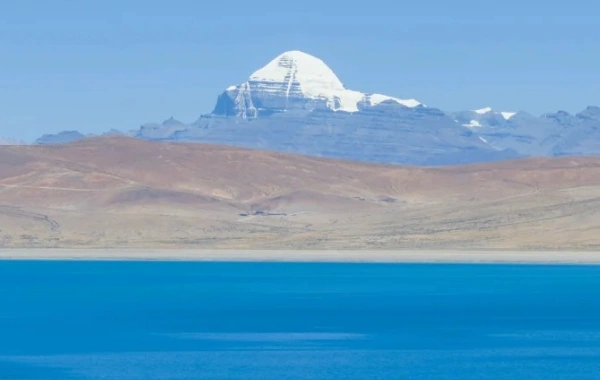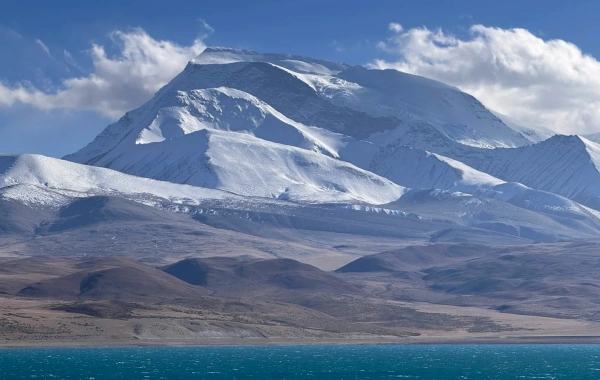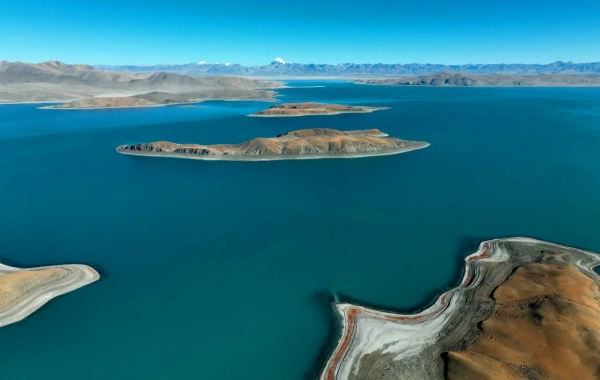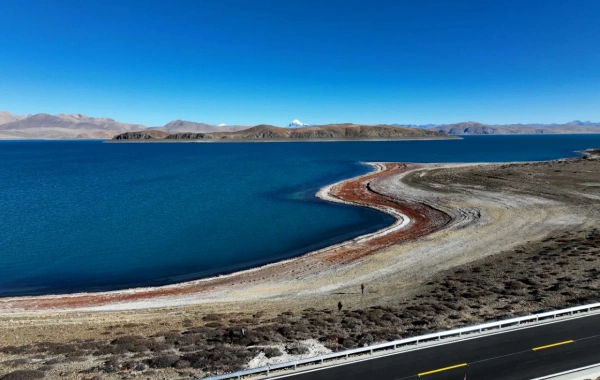Rakshastal Lake
Rakshastal Lake
Rakshastal Lake, also known as the "Ghost Lake," is a mysterious and intriguing body of water located in the Himalayas, adjacent to the sacred Lake Manasarovar in Tibet, China. It lies at an altitude of about 4,575 meters above sea level. Unlike its neighboring holy lake, Rakshastal has a reputation for being ominous and is shrouded in local legends and religious symbolism. The lake's unique characteristics and its juxtaposition with the holy Lake Manasarovar make it a fascinating destination for travelers and spiritual seekers alike.

Historical and Cultural Overview
Rakshastal Lake holds a significant place in local folklore and religious beliefs. In Hindu and Buddhist traditions, it is often associated with evil and darkness, in contrast to the purity and sanctity of Lake Manasarovar. According to ancient myths, Rakshastal was created by the demon king Ravana, and it is said to be a place where negative energies reside. Over the centuries, these stories have been passed down through generations, shaping the cultural perception of the lake. Despite its negative connotations, the lake continues to attract pilgrims and tourists who are intrigued by its mysterious allure and the opportunity to explore the boundary between good and evil as represented by the two adjacent lakes.
Geographical Features
Rakshastal Lake is a saltwater lake with a dark blue to blackish hue, which adds to its eerie appearance. It has an irregular shape, with a length of approximately 25 kilometers and a width of about 10 kilometers. The lake's surface is often calm, reflecting the surrounding mountains and sky, creating a surreal and otherworldly landscape. The lake is fed by several small streams and glaciers, but it has no outlet, which contributes to its high salinity. The surrounding terrain is rugged and barren, with rocky slopes and sparse vegetation, further emphasizing the lake's isolation and desolation.

Major Attractions
Mysterious Waters: The dark and still waters of Rakshastal Lake create an atmosphere of mystery and intrigue. Visitors can stand on the shore and gaze out at the lake, feeling a sense of awe and wonder at its vastness and depth. The contrast between the lake's dark surface and the bright blue sky above is a striking sight that is sure to leave a lasting impression.
Surrounding Mountains: The lake is surrounded by majestic mountains, including the towering peaks of the Himalayas. These mountains provide a stunning backdrop to the lake and offer opportunities for hiking and exploration. From certain vantage points, visitors can enjoy panoramic views of the lake and the surrounding landscape, taking in the beauty and grandeur of nature.
Local Monasteries: There are several small monasteries located near Rakshastal Lake, which are important centers of Buddhist worship and meditation. These monasteries offer a glimpse into the local religious culture and provide a peaceful and serene environment for visitors to reflect and pray. Visitors can interact with the monks and learn about their way of life and spiritual practices.

Suggested Itineraries
Half-Day Exploration (3–4 hours):
Start at the lakeshore of Rakshastal Lake and take a leisurely walk along the edge, taking in the views of the lake and the surrounding mountains.
Visit one of the nearby monasteries, such as Chiu Gompa Monastery, and learn about the local Buddhist culture and traditions.
Enjoy a picnic lunch by the lake, savoring the peaceful atmosphere and the stunning scenery.
Full-Day Adventure (6–8 hours):
Begin the day with an early morning visit to Rakshastal Lake to witness the sunrise over the mountains and the lake. The changing colors of the sky and the reflection on the lake's surface create a magical sight.
Embark on a short hike in the surrounding hills, exploring the rugged terrain and enjoying the fresh mountain air.
Have lunch at a local tea house or restaurant, sampling traditional Tibetan cuisine.
In the afternoon, visit another nearby attraction, such as Mount Kailash or Lake Manasarovar, depending on your interests and time constraints.
Multi-Day Spiritual Journey (3–5 days):
Day 1: Arrive at Rakshastal Lake and check into a local guesthouse or campsite. Spend the afternoon exploring the lake and its surroundings, getting familiar with the area.
Day 2: Participate in a meditation or yoga session by the lake, led by a local monk or instructor. This will help you connect with the spiritual energy of the place and find inner peace.
Day 3: Join a pilgrimage tour to Mount Kailash or Lake Manasarovar, depending on your religious beliefs and interests. This will give you a deeper understanding of the local culture and spiritual significance of the region.
Day 4: Spend the day reflecting on your experiences and enjoying the tranquility of Rakshastal Lake. You can read a book, write in a journal, or simply sit and meditate by the lake.
Day 5: Depart from Rakshastal Lake, taking with you memories of a unique and unforgettable spiritual journey.
Ticket Purchase
There is no specific entrance fee to visit Rakshastal Lake itself. However, if you plan to visit nearby monasteries or participate in certain activities, there may be small fees or donations required. It is adVisable to carry some cash with you, as credit cards may not be widely accepted in this remote area. Additionally, if you are joining a guided tour or hiring a local guide, make sure to discuss the costs and payment arrangements in advance.

Transportation
By Air: The nearest Airport to Rakshastal Lake is in Lhasa, the capital of Tibet. From Lhasa, you can take a domestic flight to a smaller airport closer to the lake, such as Ngari Gunsa Airport. However, flight options may be limited, and it is advisable to book your tickets well in advance.
By Land: The most common way to reach Rakshastal Lake is by road. You can take a long-distance bus from Lhasa or other major cities in Tibet to a town near the lake, such as Darchen. The journey by bus can be long and arduous, but it offers an opportunity to see the beautiful Tibetan landscape along the way. Alternatively, you can hire a private car or join a guided tour, which will provide more comfort and flexibility.
Local Transport: Once you arrive in the vicinity of Rakshastal Lake, you can use local transport options such as taxis or motorbikes to get around. However, be prepared for rough roads and limited transportation services in this remote area.
Best Time & Tips
Best Time to Visit: The best time to visit Rakshastal Lake is during the summer months from June to September when the weather is relatively mild and the roads are more accessible. The temperatures during this time range from 10°C to 20°C, making it comfortable for outdoor activities. Avoid visiting during the winter months from November to February, as the region experiences extremely cold temperatures and heavy snowfall, which can make travel difficult and dangerous.
Tips:Acclimatization: Due to the high altitude of Rakshastal Lake, it is essential to acclimatize properly before visiting. Spend a few days in Lhasa or other lower-altitude areas to allow your body to adjust to the thin air. This will help prevent altitude sickness and ensure a more enjoyable trip.
Respect Local Customs: Rakshastal Lake is a sacred place for many local people, so it is important to respect their customs and traditions. Dress modestly, especially when visiting monasteries or other religious sites, and follow the instructions of your guide or local authorities.
Environmental Protection: The region around Rakshastal Lake is fragile and vulnerable to environmental damage. Help protect the environment by not littering, staying on designated trails, and avoiding any activities that could harm the natural ecosystem.
Photography: Photography is allowed at Rakshastal Lake, but be mindful of the local culture and religious sensitivities. Avoid taking photos of people without their permission, especially monks and pilgrims. Also, be careful not to disturb the natural beauty of the lake while taking your pictures.
Emergency Preparedness: In case of an emergency, such as altitude sickness or injury, make sure you have a plan in place. Carry a first-aid kit, sufficient water, and warm clothing with you at all times. It is also advisable to have travel insurance that covers medical emergencies and evacuation in remote areas.

Nearby attractions:
Recommend Trip
China Pilgrimage Adventure Tour
If you would like to ask more questions about attractions or have a personalized itinerary, please contact usIf you would like to ask more questions about attractions or have a personalized itinerary, please contact us
Contact Us
What Our Clients Say?
Based on 10,000+ traveler reviews













